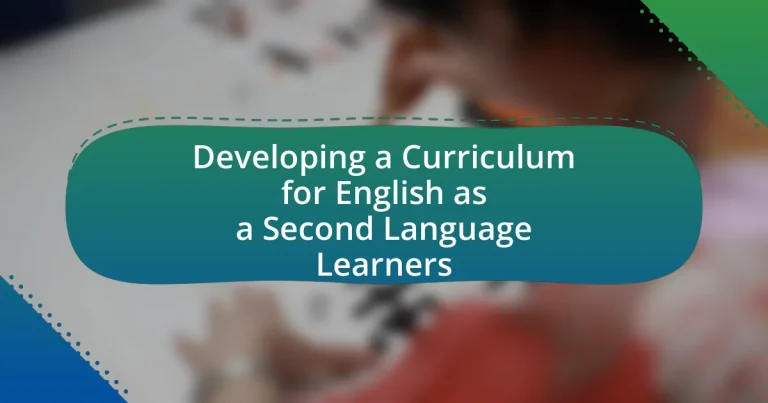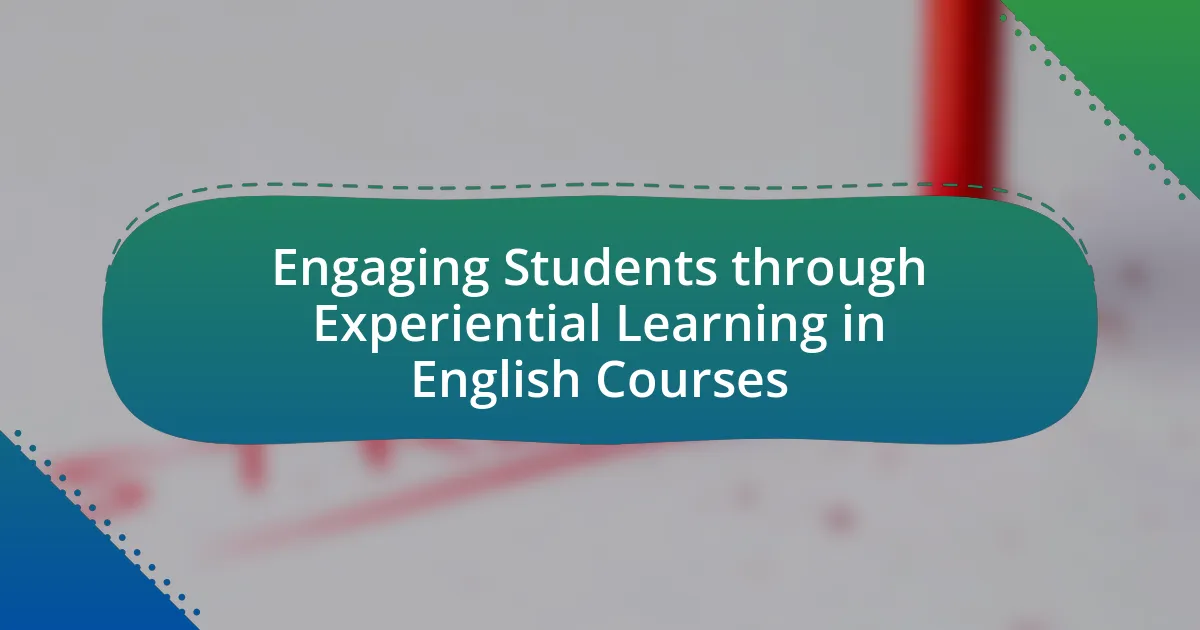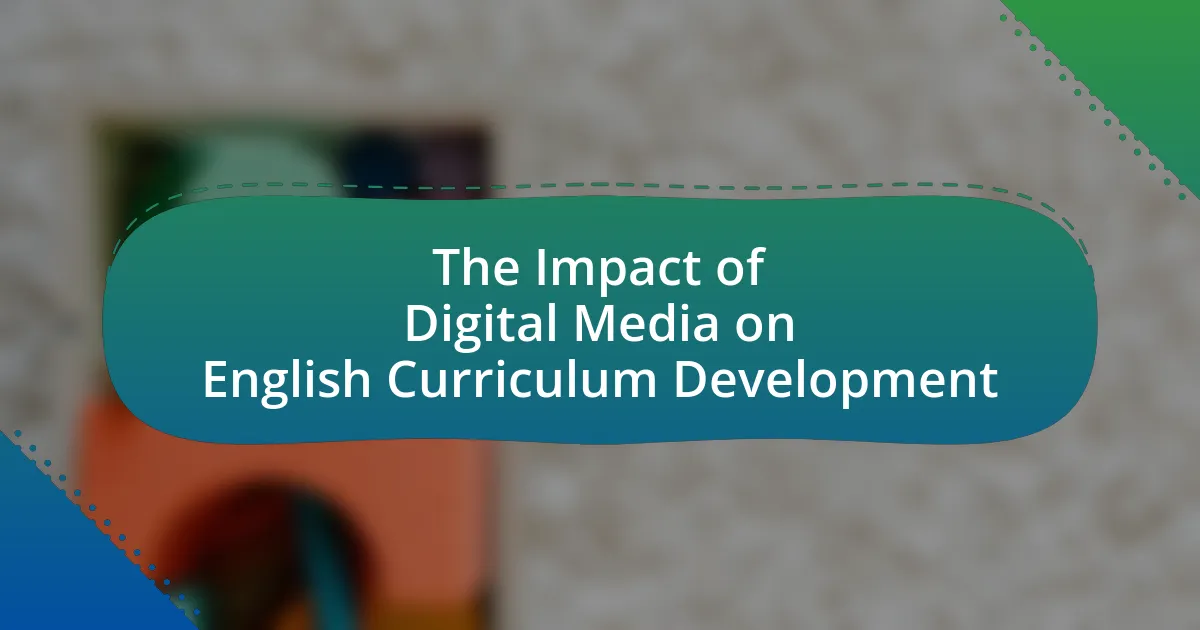Developing a curriculum for English as a Second Language (ESL) learners involves creating a structured educational framework tailored to the unique language acquisition needs of non-native speakers. This article outlines the necessity of specialized curricula that address linguistic and cultural challenges faced by ESL learners, emphasizing the importance of clear learning objectives, communicative competence, and culturally relevant materials. Key components of an effective ESL curriculum include integrating language skills—listening, speaking, reading, and writing—along with appropriate assessment methods and differentiated instruction strategies to accommodate diverse proficiency levels. Additionally, the article discusses the role of technology and online resources in enhancing language learning, while highlighting best practices and common pitfalls in curriculum development.

What is Developing a Curriculum for English as a Second Language Learners?
Developing a curriculum for English as a Second Language (ESL) learners involves creating a structured educational framework that addresses the specific language acquisition needs of non-native speakers. This process includes identifying learning objectives, selecting appropriate materials, and designing assessments that cater to diverse proficiency levels. Research indicates that effective ESL curricula incorporate communicative language teaching methods, which enhance learners’ speaking, listening, reading, and writing skills in real-life contexts. For instance, the TESOL (Teachers of English to Speakers of Other Languages) standards emphasize the importance of integrating language skills with content knowledge to facilitate meaningful learning experiences for ESL students.
Why is a specialized curriculum necessary for ESL learners?
A specialized curriculum is necessary for ESL learners because it addresses their unique linguistic and cultural needs, facilitating effective language acquisition. ESL learners often come from diverse backgrounds and may have varying levels of proficiency in English, which a general curriculum may not adequately support. Research indicates that tailored instructional strategies, such as scaffolding and differentiated instruction, significantly enhance language learning outcomes for these students. For instance, a study by Short and Echevarria (2005) found that specialized curricula improve comprehension and engagement among ESL students, leading to better academic performance.
What unique challenges do ESL learners face in language acquisition?
ESL learners face unique challenges in language acquisition, primarily due to differences in linguistic backgrounds, cultural contexts, and cognitive processing. These learners often struggle with transferring knowledge from their native language to English, which can lead to difficulties in grammar, vocabulary, and pronunciation. For instance, research indicates that ESL students may experience interference from their first language, affecting their ability to grasp English syntax and idiomatic expressions. Additionally, cultural differences can impact communication styles and social interactions, making it harder for ESL learners to engage in classroom discussions and collaborative activities. Furthermore, cognitive load can be higher for these learners, as they must simultaneously decode language and comprehend content, which can hinder their overall learning process.
How does cultural background influence ESL learning?
Cultural background significantly influences ESL learning by shaping learners’ attitudes, motivations, and approaches to language acquisition. For instance, students from collectivist cultures may prioritize group harmony and collaborative learning, impacting their participation in classroom activities. Research indicates that cultural values affect communication styles; for example, learners from high-context cultures may rely on non-verbal cues and implicit understanding, which can lead to misunderstandings in a more direct communication environment typical in ESL settings. Additionally, cultural familiarity with educational practices can affect how students engage with the curriculum, as those accustomed to rote memorization may struggle with critical thinking tasks emphasized in Western education systems.
What are the key components of an effective ESL curriculum?
An effective ESL curriculum includes clear learning objectives, a focus on communicative competence, culturally relevant materials, assessment strategies, and opportunities for real-world practice. Clear learning objectives guide instruction and ensure that students understand what they are expected to achieve. A focus on communicative competence emphasizes the ability to use language effectively in various contexts, which is essential for language acquisition. Culturally relevant materials engage students by connecting language learning to their experiences and backgrounds. Assessment strategies, such as formative and summative assessments, help track progress and inform instruction. Finally, opportunities for real-world practice, such as conversation clubs or language exchanges, enhance language skills through practical application. These components are supported by research indicating that structured, relevant, and interactive approaches lead to better language outcomes for ESL learners.
What role do language skills (listening, speaking, reading, writing) play in the curriculum?
Language skills—listening, speaking, reading, and writing—are fundamental components of the curriculum for English as a Second Language (ESL) learners, as they facilitate comprehensive language acquisition and communication proficiency. Each skill plays a distinct role: listening enhances comprehension and the ability to process spoken language; speaking develops verbal communication and interaction; reading fosters understanding of written texts and vocabulary expansion; and writing encourages expression and the application of language rules.
Research indicates that integrating these skills into the curriculum leads to improved language outcomes. For instance, the National Literacy Trust emphasizes that balanced instruction across all four skills supports learners in becoming proficient communicators. Additionally, the Common European Framework of Reference for Languages outlines that effective language education requires a holistic approach, where all skills are interconnected and reinforce one another. Thus, the inclusion of listening, speaking, reading, and writing in the ESL curriculum is essential for fostering overall language competence.
How can assessment methods be integrated into the curriculum?
Assessment methods can be integrated into the curriculum by aligning them with learning objectives and instructional strategies. This alignment ensures that assessments are relevant and measure the intended outcomes of the curriculum. For example, formative assessments, such as quizzes and peer reviews, can be used throughout the learning process to provide ongoing feedback, while summative assessments, like final projects or exams, can evaluate overall student understanding at the end of a unit. Research indicates that integrating assessments in this manner enhances student engagement and improves learning outcomes, as evidenced by studies showing that formative assessments can lead to a 20% increase in student performance (Black & Wiliam, 1998).
How can educators tailor the curriculum to meet diverse learner needs?
Educators can tailor the curriculum to meet diverse learner needs by implementing differentiated instruction strategies. This approach allows educators to modify content, process, and products based on individual student readiness, interests, and learning profiles. For instance, research by Tomlinson (2001) emphasizes that differentiated instruction can enhance engagement and achievement among diverse learners by providing multiple avenues for learning. Additionally, using formative assessments helps educators identify specific learner needs and adjust the curriculum accordingly, ensuring that all students, including English as a Second Language learners, receive appropriate support and resources.
What strategies can be used to accommodate different proficiency levels?
To accommodate different proficiency levels in English as a Second Language (ESL) learners, differentiated instruction is essential. This strategy involves tailoring teaching methods and materials to meet the diverse needs of learners. For instance, teachers can use leveled texts that provide varying degrees of complexity, allowing students to engage with content that matches their proficiency. Additionally, employing scaffolding techniques, such as providing visual aids or sentence starters, supports learners in building their language skills progressively. Research indicates that differentiated instruction enhances student engagement and achievement, as it addresses individual learning styles and paces (Tomlinson, 2001).
How can educators incorporate students’ interests and backgrounds into the curriculum?
Educators can incorporate students’ interests and backgrounds into the curriculum by utilizing culturally relevant pedagogy and differentiated instruction. Culturally relevant pedagogy emphasizes the importance of including students’ cultural references in all aspects of learning, which can enhance engagement and understanding. For example, educators can integrate literature, examples, and case studies that reflect the diverse backgrounds of their students, thereby making the content more relatable. Differentiated instruction allows educators to tailor lessons based on students’ interests, learning styles, and cultural contexts, which has been shown to improve academic performance and motivation. Research by Ladson-Billings (1994) highlights that students perform better when their cultural backgrounds are acknowledged and integrated into the learning process.
What are the best practices for developing an ESL curriculum?
The best practices for developing an ESL curriculum include aligning the curriculum with learners’ needs, incorporating diverse teaching methods, and integrating cultural context. Aligning the curriculum with learners’ needs ensures that the content is relevant and engaging, which is supported by research indicating that tailored instruction improves language acquisition outcomes. Incorporating diverse teaching methods, such as communicative language teaching and task-based learning, caters to different learning styles and promotes active participation, as evidenced by studies showing increased student engagement and retention. Integrating cultural context not only enhances language learning but also fosters intercultural competence, which is crucial in a globalized world.
How can collaboration among educators enhance curriculum development?
Collaboration among educators enhances curriculum development by fostering diverse perspectives and expertise, which leads to more comprehensive and effective curricula. When educators work together, they can share best practices, resources, and insights that address the unique needs of English as a Second Language learners. Research indicates that collaborative curriculum design can improve student engagement and learning outcomes, as it allows for the integration of varied teaching strategies and cultural contexts. For instance, a study published in the “Journal of Educational Research” found that collaborative efforts among teachers resulted in a 20% increase in student performance in language acquisition, demonstrating the tangible benefits of teamwork in curriculum development.
What resources are available for ESL curriculum development?
Resources available for ESL curriculum development include textbooks, online platforms, and professional organizations. Textbooks such as “English for Academic Purposes” and “The ESL/ELL Teacher’s Survival Guide” provide structured content and lesson plans. Online platforms like ESL Library and British Council offer interactive materials and teaching resources. Professional organizations, including TESOL International Association and the National Council of Teachers of English, provide guidelines, research, and networking opportunities for educators. These resources collectively support the creation of effective ESL curricula by offering diverse instructional strategies and materials tailored to various learner needs.
How can technology be utilized in ESL curriculum development?
Technology can be utilized in ESL curriculum development by integrating digital tools and resources that enhance language learning experiences. For instance, online platforms such as Duolingo and Rosetta Stone provide interactive language exercises that cater to various proficiency levels, allowing learners to practice at their own pace. Additionally, the use of multimedia resources, including videos and podcasts, can improve listening and comprehension skills, as evidenced by research from the University of Michigan, which found that multimedia instruction significantly boosts language acquisition. Furthermore, technology facilitates collaborative learning through tools like Google Classroom, enabling students to engage in group projects and discussions, thereby enhancing their communication skills in a real-world context.
What digital tools can support language learning in the curriculum?
Digital tools that can support language learning in the curriculum include language learning apps, online platforms, and interactive software. Language learning apps like Duolingo and Babbel provide structured lessons and gamified experiences that enhance vocabulary and grammar skills. Online platforms such as Rosetta Stone and Busuu offer immersive language experiences with speech recognition technology, allowing learners to practice pronunciation and conversation. Interactive software like Quizlet and Kahoot! enables educators to create engaging quizzes and flashcards, reinforcing language concepts through active participation. These tools have been shown to improve language acquisition rates, as evidenced by studies indicating that learners using digital tools demonstrate higher retention and engagement compared to traditional methods.
How can online resources be effectively integrated into the curriculum?
Online resources can be effectively integrated into the curriculum by aligning them with learning objectives and ensuring they complement traditional teaching methods. This integration can enhance engagement and provide diverse learning materials, such as interactive exercises, videos, and forums that cater to various learning styles. Research indicates that using online resources can improve language acquisition; for instance, a study by Chen and Hwang (2018) found that students using blended learning approaches showed a 20% increase in language proficiency compared to those relying solely on traditional methods. By strategically incorporating these resources, educators can create a more dynamic and effective learning environment for English as a Second Language learners.
What are the common pitfalls in developing an ESL curriculum?
Common pitfalls in developing an ESL curriculum include a lack of alignment with learners’ needs, insufficient cultural relevance, and inadequate assessment methods. When the curriculum does not consider the specific language goals and backgrounds of the learners, it fails to engage them effectively. Research indicates that culturally relevant materials enhance motivation and comprehension, yet many curricula overlook this aspect. Furthermore, ineffective assessment methods can lead to misinterpretation of learners’ progress, as standardized tests may not accurately reflect language acquisition in diverse contexts.
How can educators avoid cultural insensitivity in curriculum design?
Educators can avoid cultural insensitivity in curriculum design by incorporating diverse perspectives and materials that reflect the backgrounds of all students. This approach ensures that the curriculum is inclusive and representative of various cultures, which fosters a respectful learning environment. Research indicates that culturally responsive teaching improves student engagement and academic performance, as highlighted in the work of Gay (2010) in “Culturally Responsive Teaching: Theory, Research, and Practice.” By actively seeking input from students and their families, educators can better understand cultural nuances and avoid stereotypes, leading to a more equitable educational experience.
What are the risks of a one-size-fits-all approach in ESL curriculum?
The risks of a one-size-fits-all approach in ESL curriculum include inadequate addressing of diverse learner needs, which can lead to ineffective language acquisition. This approach fails to consider variations in students’ backgrounds, learning styles, and proficiency levels, resulting in disengagement and frustration. Research indicates that tailored instruction significantly enhances language learning outcomes; for instance, a study by Tomlinson (2014) highlights that differentiated instruction improves student engagement and achievement in diverse classrooms. Therefore, a uniform curriculum can hinder the effectiveness of ESL education by not accommodating the unique characteristics of individual learners.
What practical tips can educators follow when developing an ESL curriculum?
Educators developing an ESL curriculum should prioritize the integration of real-life language use and cultural context. This approach enhances language acquisition by making learning relevant and engaging. Incorporating authentic materials, such as newspapers, videos, and literature from English-speaking cultures, allows learners to connect language with real-world scenarios. Additionally, differentiating instruction to meet diverse learner needs, including varying proficiency levels and learning styles, is essential. Research indicates that tailored instruction significantly improves language outcomes (Tomlinson, 2014). Regular assessment and feedback mechanisms should also be embedded to monitor progress and adjust teaching strategies accordingly, ensuring that the curriculum remains effective and responsive to student needs.



